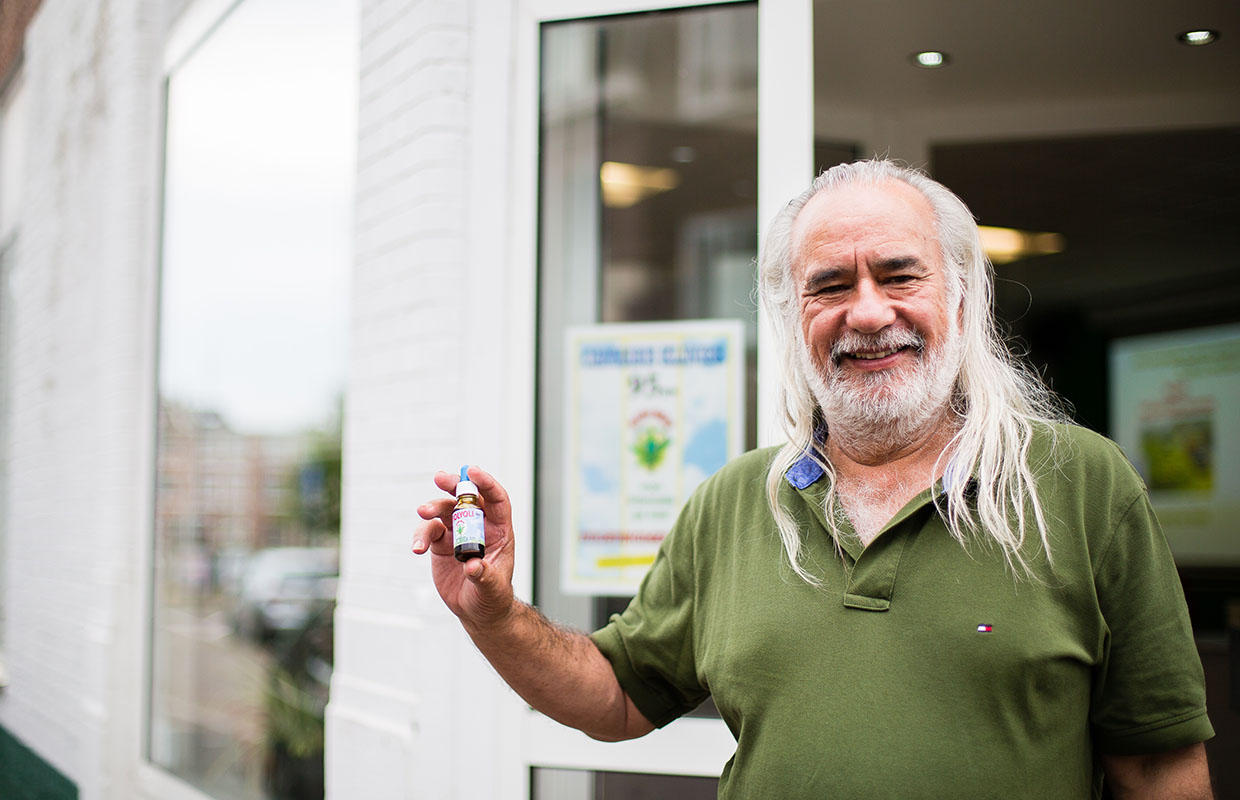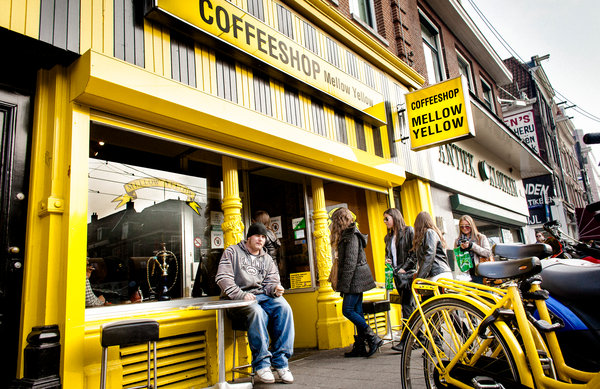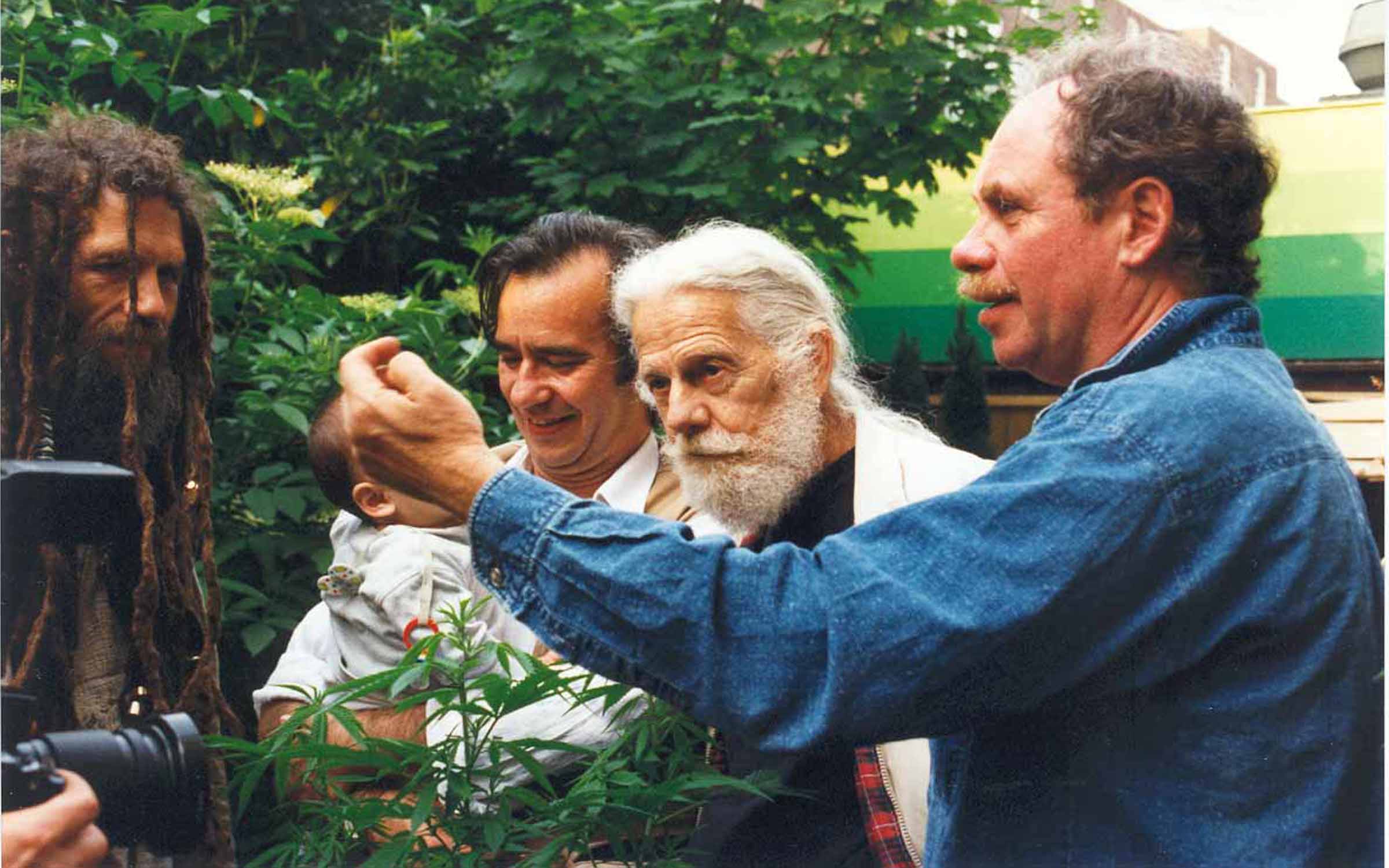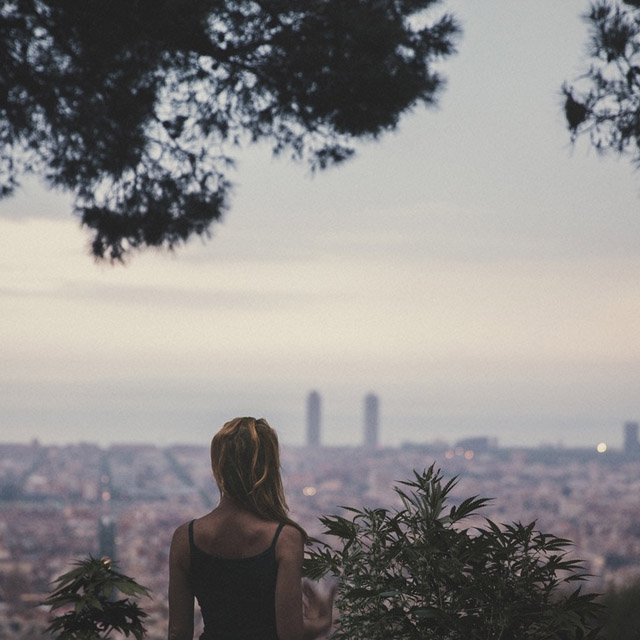- Best known for being the father of the coffee shop revolution, there’s much more to Wernard Bruining than just the creation of the Mellow Yellow.
- Among other achievements, this tireless activist introduced sinsemilla cannabis in Europe and contributed to the development of hybrids in The Netherlands during the 80’s.
- An idealistic dreamer and a creative soul, this true hippy took cannabis growing, selling and consumption to a level never seen before in Europe.
- In this interview, he shares the secrets of a period that saw the clandestine creation of the world’s most legendary strains.

Bruining arrives on time for our meeting at the Utrecht railway station café. Judging by his looks, no one would ever guess this long-haired, ever-smiling Dutchman was one of the biggest players in the history of cannabis. At the age of almost 70, his eyes are still inquisitive, almost child-like. Friendly and dressed inconspicuously, he is one of those people that, for some reason, make you feel at home.
In 1973, before the Opium Act was changed, you opened the first coffee shop in the world, let's say... in an unlawful manner. Why did you take that big a risk?
Back then I shared a small house with another nine people, we were all cannabis smokers, and we constantly had friends come to us for a smoke, and to buy something. It was perfect because we had free smokes all the time. And whenever we needed money, we went to an agency, worked for a couple of weeks, until we had enough, and quit. In 1973 we squatted the old bakery, and since we were always around smoking and drinking tea, we had this joke that we should open up a coffee shop. That way we would live off the coffee and the tea we sold, have free smokes and forget about working for the agencies.
As the situation continued, eventually I registered the company under the name Mellow Yellow, a code name, because Mellow Yellow was a song by Donovan which basically says "If you've got nothing to smoke, bake banana peels and then smoke them." All the smokers knew the song, but not the regular people, so it was the perfect name.
It was not something you planned, then…
Not at all, it just happened. In the old days, before the coffee shops, the only way to buy hash was going to a place where there were lots of smokers, and you met up with dealers, who would say to you: "Oh, you wanna by hash? You wanna buy hash?" And if you were like "Well…," they showed you something, surrounded you and you really had to buy.
They had little pieces in aluminium foil, which they partially unwrapped so that you could smell it, and when you got home and open the package, most of it was dog cookies. So we decided to take dealing to a higher level.
We pre-bagged everything in plastic bags so that you could see what's in it. We also made standard deals - 10 and 25 guilders - so there was no need to haggle. That was the model we started, which eventually became the coffee shop model.
There was always one dealer, which was one of us, sitting in front of the bar, pretending to be just a customer so that the police couldn't shut down the place. In the old days, the law was like that, if you had customers that were smoking, as an owner, you were not responsible for that.
What type of product did you sell in the early days?
Black hash, blond hash, cannabis, Thai sticks, that sort of things.
We decided to take dealing to a higher level. That was the model we started, which eventually became the coffee shop model.
Tell us a bit about those first years at the legendary Mellow Yellow. Did you expect it to become so famous?
Not at all, we were just interested in the opposite, we didn't want to be noticed. And then one day we started to have these long queues of people waiting in line outside the shop. Of course, that was something that was noticed by a lot of people, taxi drivers, but also people like Henk de Vries, who thought: "What these hippies do, I can do as well, and I can do better."
Because we were not really that organised. When we wanted to play table football, we made customers wait. We only opened when we were awake, which was somewhere in the afternoon. What Henk did with the Bulldog was establish an official, mature business, with regular hours and that sort of things. We were just doing it the hippie way, we were not interested in money, we were interested in having a nice life and a nice smoke.
How do you feel about being the father of the coffee shop movement?
I didn't realise it at all. I just went on doing things the way I felt that had to be done, and years later people started to say to me: "Oh, you started the coffee shop movement." But officially, I always say Henk's Bulldog was the first coffee shop.
As you now, Henk had a lot of trouble with the police. He sometimes had five police raids a day, I would not have survived that. He did. Once he woke up in the morning and his whole bedroom was filled with cops. Guys like him fought the real war. We started it sort of, but we didn't fight it.
At that time, you were just 23. How does a 20-year-old live with so much money? In which way did your lifestyle change?
My parents used to earn a very good salary, so I'm used to money. Before the Mellow Yellow I worked for a bank for some time and I was responsible for over 300,000 guilders. I didn't care, it was worth nothing to me, it's just paper. My lifestyle didn't change much, to tell the truth.
Fire seems to have played a major part in Mellow Yellow's life. You occupied an abandoned bakery located on Weeperzijde St because your place had caught fire and, in 1978, your coffee shop burnt down too. Do you believe in coincidence?
No, I'm certain that everything I do is connected with the universe, and if you're open to that, the universe will relate to you more and more. When the Mellow Yellow went on fire, I looked at the situation and thought it may just be an occasion to do something else.

When the Mellow Yellow disappeared, you decided to travel to the U.S. and discovered sinsemilla cannabis. How did you step into the elite of American growers?
I remember that an American guy who used to come to our shop always said "if you're ever in the States, just come and see me." Suddenly, I had my hands free to do that and I thought, why not. This American guy happened to be very well connected in the cannabis community, and gave me the opportunity to see how they did it in America. It was so different to what we were used to, the way they grew and treated cannabis.
Americans where growing cannabis of a different quality than what we knew in Holland. I was almost one of the first to sell cannabis, mostly Indonesian grass. But then I saw these American guys grow cannabis. It was cannabis without seeds and they were very careful with the quality. In my time, a kilo of Indonesian grass would cost you about 1,000 guilders and we would sell it for 1,500. In America, they were selling kilos for 8,000 dollars. I was like "What?" Until I smoked it. It was so much better, Americans are very quality aware.
How did you come up with the idea of bringing that weed to Holland? How did you do it?
When I discovered sinsemilla cannabis in the States, I immediately thought we had to take it to Holland - the legal framework was more favourable there - and show people how to grow those American strains the American way. At first, we imported them in suitcases, we had a group of couriers. We just set up a system and no one was ever caught.
Then we started to import cars filled up with cannabis, refrigerators, it was crazy. This cannabis, I used to sell it to Henk, for the Bulldog. It was about 12,000 guilders a kilo, the most expensive grass. Then he sold it for 25 guilders a gram in the coffee shop, double the price.
That's how we realised that producing it directly in Holland was much more profitable. So we grouped up with a couple of guys and called ourselves the Green team. One of these guys was a 65-year-old American, Old Ed. He was the grower, the one who knew about strains, how to grow them... We teamed up and said we were going to make Holland the Jamaica of Europe. I had to tell the Dutch that the secret was in the seeds, that strains are all that matters. So I said to the Americans that if we were going to promote this idea of growing in Holland, we needed to do two things: make the weed available in coffee shops and spread the secret. I wanted to be allowed to tell the secret to everybody. I wanted to promote growing.
So Old Ed moved to Holland with his strains?
Exactly. We borrowed some money from some Americans who had made a fortune during the prohibition days, and we used that money to buy a farm in Holland. The idea was to grow cannabis and sell it to coffee shops. The first year we produced 5-10 kilos.
The second year we harvested a little bit more and the third year we grew a thousand plants. Then a policeman came up to our farm and said: "What are you guys doing here? Don't try this again." So we had to find a new home for a thousand plants. We started to phone friends, basically everyone we knew, and one of these people was Ben Dronkers. But a thousand plants meant we had 30/40 locations, so eventually we lost the exclusive rights over the American strains, which, as expected, got dispersed among different people.
In 1985, Sam the Skunkman joined the Green Team. How did the Dutch scenario change with the arrival of Skunk? How was it different from Old Ed's strains?
We were contacted by two Americans who wanted to join the team, Sam The Skunkman and Ed Rosenthal. We were undecided, so we sent them both a ticket, asked them to come over and selected who to work with. Sam the Skunkman brought in Skunk, so he became the guy to work with. Then the green team changed. From an idealistic organisation, it became an organisation aimed at making money.
By the time Sam the Skunkman joined, we had some other American partners. They had a strain called number1, they were in favour of Northern Lights, things like that. And they were talking about making money. Skunk was the strain that really broke the ice, it had less leaves and more hair. Before Skunk, people were not into grass in Holland, they preferred hash. But as soon as Skunk hit the coffee shops, selling was not a problem any more.
At first we used suitcases. Then we started to import cars filled up with cannabis, refrigerators, it was crazy.
In 1986, you quit the Green Team. Why?
Everything was changing very fast. Within a couple of days, we were talking about five greenhouses and harvests of 100 kilos, things were getting out of control. There was no idealistic reason behind it. It was getting riskier, more stressful and it was just for making money. So I said "No, thank you" and left the Green Team.
What did you do after the Green Team?
Again, one thing led to another and I ended up buying lights in America for growing indoors in Holland. Then I decided to design my own lighting system and a friend of mine started to produce them in the garage at the back of my house.
In 1995, it became a business and we called it Positronics. We also did seeds, all those strains I had been working on. To me, seeds are really valuable, they're like microchips that contain all the secret information from the breeder.
What strains did you sell in the early days of Positronics?
We took the strains we already had and numbered from 1 to 50. Then, in the second year we started to make crosses, so no. 2 x no. 10, and that was Viking. Then Viking crossed with Skunk, which was Holland's Hope, things like that.

So you focused on Positronics…
Not really. A new idea crossed my mind and I started to make fertilizers, until, again, it became so much business that I asked a friend of mine to take it over. It was a lot of work and I don't like work. He accepted and made it an official business. He came up with a really good name, BioBizz, and made it work really well.
In 1988, Sam the Skunkman won the first Cannabis Cup held in Amsterdam with his Skunk#1, after which he curiously decided to sell all his seeds and genetics to Neville. Do you know why?
I know nothing about that, I only know Neville did something that was really un-Dutch. He started to promote himself in High Times. There's this famous picture of him with lots of money and hash… After that, he had lots of run-ins with the law, until he was locked up in jail in Australia. If I'm not wrong, he was bailed out by Ben Dronkers. Ben Dronkers, same thing with Henk from Bulldog, they're really good businessmen. They have the capability to continue in a business for ever and ever and ever; and make it bigger and bigger and bigger. I'm not like that, I can create something, but once it's created I lose interest.
What do you make of the legalisation wave we've been witnessing in recent years?
I think it's fake. I've always said "Once cannabis gets legalised, I'll stop smoking." Smoking cannabis has to do with mental freedom, and if you have to smoke what the Government grows for you, you're not free. They decide what you smoke.
It's not a matter of who is allowed or who gets a licence to produce it. First, everybody has to be allowed to grow it and use it, then you can say "Ok, let's create a system on top of that to legalise it." But the way it's done now is the opposite way. It's the governments and businessmen that decide to create a system to provide the public with cannabis.
I think that we can only talk if the governments admit that they started the war on cannabis, that they are the criminals and that they've caused a lot of trouble to regular people. If the governments say "mea culpa", then we can talk. Otherwise, my answer is "I don't want to smoke something that you grew, with your dirty, blood-stained hands. We don't want you in our business."
The main difference between animals and humans is that humans have the freedom to make decisions. And when you take that freedom away you reduce people to animals. When I was 18 I wanted to become a teacher, until I started to smoke cannabis. It was then that I became aware that school and teaching had nothing to do with creating situations in which people can grow personally, is training people to behave the way other people want to. And it happened because of smoking (laughs).
Do you have any regrets? If you could go back in time, is there anything you would do differently?
I don't regret anything really. There are so many things that I could have done better, probably, but that's the process of learning. Maybe it's good that you're not so aware of things because, otherwise, when you think too much, you don't create things.
What is your biggest professional success?
What I do today. It's much more important than what I did with grow shops and coffee shops. In 1995, I woke up one day with a clear idea in my mind: medical cannabis and nothing else. I realised that I had to make people aware that cannabis has medicinal properties. That's why I created the cannolator, a device to make your own THC oil that allows patients to treat themselves.



Comments from our readers
Read comments in other languages:
Did you like this post?
Your opinion about our seeds is very important to us and can help other users a lot (your email address won't be made public).